The Happiness of the Katakuris (2001)
Directed by: Takashi Miike
Written by: Kikumi Yamagishi
Starring: Keiko Matsuzaka, Kenji Sawada, Naomi Nishida, Shinji Takeda
JAPAN
AKA KATAKURI-KE KOFUKU
AVAILABLE ON DUAL FORMAT BLU-RAY AND DVD: Now, from ARROW VIDEO
RUNNING TIME: 113 min
REVIEWED BY: Dr Lenera, Official HCF Critic
The Katakuris are Masao who has just lost his job as a shoe salesman, his father Jinpei who does nothing except pretending to be stupid, his wife Terue, his formerly criminal son Masayuki who has a short fuse, his daughter Shizue who is constantly falling in love and getting her heart broken, Shizue’s small daughter Turie, and their dog Pochi. The family uses the father’s redundancy pay to buy a large home situated on a former garbage dump near Mount Fuji that they have named the ‘White Lover’s Inn’. They convert it into a hotel with the hope that the building of a road would bring lots of customers. After days and days of waiting for both the road and some customers, they eventually do start to have occasional guests….except that they have a tendency to die on them….
The astoundingly prolific [if you include his TV movies, he’s so far made 87 films] Takaski Miike is still probably best known for his many Yakuza flicks and films of a very horrific and brutal nature like Ichi The Killer and Audition, but the man seems to have made films in most genres with some of them actually being children’s films. I can’t say I’ve had a huge amount of experience with his work, much of which is more successful overseas than in his native Japan, but Miike tends to have a quite wonderful feeling of spontaneity to much of his stuff, meaning that you don’t always know where a film is going or what’s around the corner, and is a good argument for the relative freedom of low budgets, though even I have trouble with some of his endings! The Happiness Of The Katakuris may be one of his very oddest pictures. In truth, it’s a bit uneven and messy, but those things actually seem to add to its charm, like much of it was made up on the spot. It’s a melding of dark comedy with the musical and just a touch of horror, though claims that it’s a ‘zombie musical’ or a ‘cannibal musical’ are misleading – there’s one guy who seems to be a cannibal, and our ever popular undead friends turn up briefly near the end – but that’s really it. Leave any normal expectations at the door though, and you should have a lot of fun with The Happiness Of The Katakuris.
The film is actually a remake of a Korean film called The Quiet Family [1998]. It seems that Miike’s script sticks fairly closely to the plot of this earlier film while adding singing, dancing and a healthy dollop of just plain madness. He decided to not let himself be restricted by a small budget in the writing of his screenplay, then, when it was obvious that he neither had the time nor the money to film three major set pieces, opted to do them with claymation. As you do. This wouldn’t work in some films but doesn’t really seem out of place in this one at all. The film was something of a dream project for Miike as he got to work with some singers and even veteran actor Tetsuro Tamba [best known to western viewers as Tiger Tanaka in You Only Live Twice] whom he’d admired for decades. Miike asked his cast to only practice the songs a couple of times, and to not work out the choreography at all, before actually shooting the numbers whereupon he usually printed the first take. Typically, the film was all but ignored in Japan, but increased Miike’s international reputation and showed that he had plenty of other interests besides extreme gore and perversion, which was almost what it seemed like for a while!
The Happiness Of The Katakuris has one of the most bonkers openings, done mostly through slightly Burton-esque stop motion claymation, that you will have seen for years, and I was sitting there open mouthed. A woman is sitting eating in a restaurant when she accidently stabs with her fork a tiny demonic creature which is in her soup. The demon proceeds to rip the woman’s uvula, then both it and the uvula fly around before the demon finally settles down to eat the uvula, which actually more resembles a heart-shaped balloon. Then the demon is eaten by a bird, and the bird is eaten by a weird stitched together thing with a zip for a mouth…and so it goes on until the surreal enacting of the ‘circle of life’ finishes with the demon being reborn in an egg. It would be stretching it, in fact it would be an outright lie, to say that the film becomes almost normal for a while after this, but things are certainly in a far less insane groove for a bit as we are introduced to the members of the Katakuri family, partly from narration by little Yurie. Despite showing right away that most of them are not the brightest sparks, the film quickly does a good job in getting the viewer on their side. I immediately warmed to these people, and wanted Masao’s hairbrained scheme to make money to succeed.
There are bonkers touches even in the early ‘scene setting’ sequences, like a TV programme where the reporter is reporting of a hotel which is using animals from the local farm to do much of the work. A sinister mood is set for a few moments when a party of female hikers on what they call a “spiritualist training trip” seem spooked by the place and quickly move on, then the power briefly goes and the first guest shows up. The film has held off on the songs up to now, but suddenly the guest, when alone in his room, starts weeping and sings a really sad song before topping himself. The next morning, the family find him dead and their over the top reactions begin another song which, as many successive ones will go on to be, consists largely of matter of fact dialogue. Frankly by now I was laughing hysterically at this film [you wouldn’t believe that suicide could be this funny], especially the ridiculous campiness of it. The film then brings in a romantic subplot involving Shizue who once again thinks she’s met the man of her dreams, and thereafter Miike lets the pace slacken in a few sections in the second half despite things soon getting worse and worse for our intrepid family, while no attempt is made to spread the songs evenly out – you can get three songs virtually following each other than twenty minutes with nary a tune. The rather ramshackle construction doesn’t really hamper enjoyment at all though.
Though not as influenced by films like The Trouble With Harry as you may expect, Miike has no shame about re-using ancient gags like someone falling into an open grave or someone on a ladder watching people having sex through a window before crashing down to the ground, and is almost going full ‘Monty Python’ come the final twenty minutes which certainly made this Python grin from ear to ear. A few of the comic moments do fall a bit flat and sometimes I got more fun out of ‘blink and miss’ things like an image of two rabbits having sex on the Moon. It sometimes feels like Miike decided to put every single thought that emitted from his crazy mind during shooting up on the screen, and you know that, with a film like this, if one bit doesn’t work too well you know the next bit probably will. Credited to Koji Endo and Koji Makaino though I reckon with much imput from Miike, the songs, whose lyrics [which during one number appear on the screen in Japanese, karaoke-style] don’t always translate too well despite the stirling efforts of Ali Kennedy who is credited with the screenplay along with Kikumi Yamagishi, are often too short to make much of an impact and aren’t generally the catchiest, but are quite diverse stylistically and the sequences they are in often very well staged despite being mostly unrehearsed first takes. Miike is great at using his imagination to compensate for having little money, like when Shizue sings of constantly being unlucky in love and goes past different versions of herself, each with a different one of her ex-boyfriends. His greatest achievement with this ‘one of a kind’ picture though is that he has made a film which can genuinely be described as a ‘feel good’ picture while avoiding sappiness and dealing with things like death and suicide.
Aside from some scenes shot with a blue tint, Miike and his cinematographer Hideo Yamamoto have little time for visual artistry but still give us some lush countryside shots. The acting is mostly on the hammy side, but also mostly appropriate. Kiyoshiro Imawano as Shizue’s beau Richard [who says he’s English but is unmistakably Japanese], gives one of the broadest performances I’ve seen in a while. I really don’t know how Miike and his crew made this movie, which by rights shouldn’t work very well at all, so good, but by some kind of magic they really have made a film which, aside from a few parts don’t come off too well, is rather infectious as long as you don’t require things like coherence. You may very well end up finding it too disjointed and whacky, but you won’t forget it in a hurry and will surely appreciate at least a few of its many unique qualities, such as the way it ends with a death scene which is actually somehow a ‘happy’ moment and will make you smile. Miike is telling us with this film to Look On The Bright Side Of Life, and it certainly made me do so, which as lots of people who know me will tell you, isn’t easy.
Rating: 









Arrow present The Happiness Of The Katakuris on Blu-ray with another simply stunning transfer with superb detail, clarity and even texture [just check out the grass blowing in the wind], while cramming on loads of extras including over an hour and a half’s worth of original Japanese material shot during its production including some intriguing behind-the-scenes footage, and a new commentary to go with the previously-heard one from the director. Of special interest to me was a look at how the stop motion claymation effects were done. Again I have to say to Arrow ‘Bravo’ for releasing the definitive version of a cult favourite!
SPECIAL FEATURES
* New High Definition digital film transfer by Shochiku Co.
* Presented in High Definition Blu-ray (1080p) and Standard Definition DVD
* Original uncompressed Stereo PCM audio
* Audio commentary by director Takashi Miike
* Audio commentary by Miike biographer Tom Mes
* Violent ’til I Die: A brand new interview with Takashi Miike
* the Making of the Katakuris – An original documentary from the film’s production featuring interviews and behind-the-scenes footage with the cast and crew
* Interviews with the Katakuris cast members Kenji Sawada, Keiko Matsuzaka, Kiyoshiro Imawano, Shinji Takeda, Naomi Nishida, Tetsuro Tanba and Miike
* Animating the Katakuris – A look at the creation of the film’s stop motion effects with animation director Hideki Kimura and Miike
* Dogs, Pimps and Agitators – A visual essay on Miike’s career by Tom Mes
* Trailer and TV Spots
* Easter Egg
* Reversible sleeve featuring original and newly commissioned artwork by the Twins of Evil
* Booklet featuring new writing on the film by author Johnny Mains; Stuart Galbraith IV on Katakuris’ star musicians Kenji Sawada and Kiyoshiro Imawano; Grady Hendrix on Katakuris and The Quiet Family, the film it remade; and a re-printed interview with Miike conducted by Sean Axmaker, illustrated with original stills

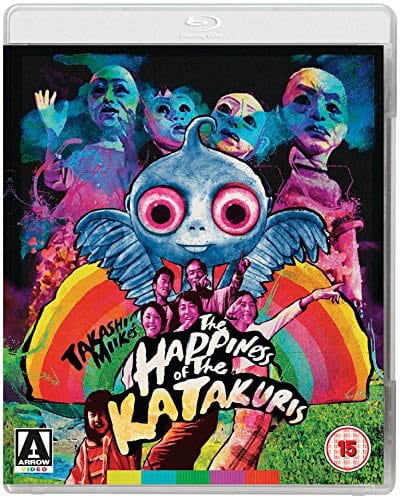
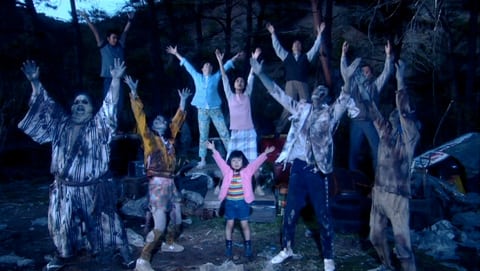
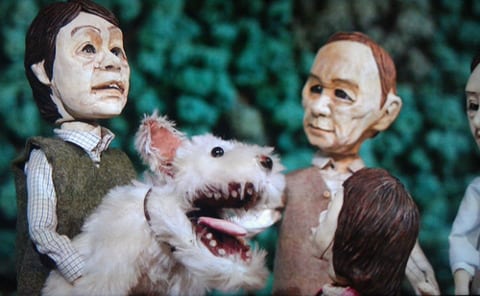

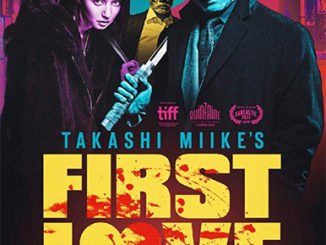

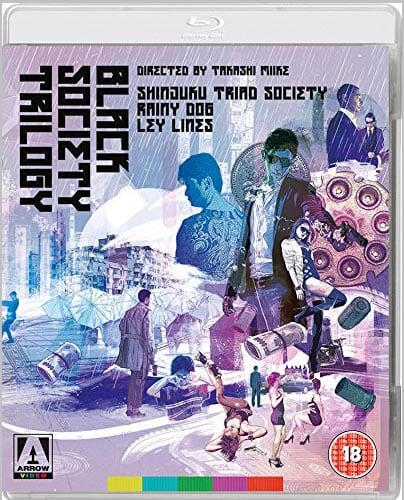
Love this film. Absolute madness ????